

4 in 10 early years educators are leaving the sector - for good. Pay and progression are known issues. Now it’s time to start looking at working pattern, too.

By Nicola Pease, Principal Consultant, Timewise
We can all agree that any functioning society needs an excellent system of early years and childcare provision. At present, our high quality early years educators are managing to provide a great service, but many are stressed, exhausted and have little to no work-life balance. In short, it’s an early years system on the edge.
While issues around pay and progression loom large with no immediate resolution in sight, let’s look to what we can fix. Building on recent successes in other shift-based, site-based sectors such as nursing, construction and retail, Timewise launched a report following an in-depth two-year project in the early years and childcare sector. Thanks to support from JPMorganChase we were able to partner with two leading childcare providers: the Early Years Alliance and the London Early Years Foundation, and get close to childcare staff, in settings.
We analysed the industry’s challenges and assessed its potential with regards to improving staff wellbeing through changes to working patterns. Sometimes, even the smallest changes can make an enormous difference. We conducted all our research and analysis whilst keeping the experiences of children and parents front of mind. If this is going to work: it has to work for everyone.
We held a packed event in Westminster, with support from the Early Education and Childcare Coalition, to launch our subsequent report, Building the early years and childcare workforce of the future, with early years providers, policymakers and local and national government representatives. We collaborated on ideas and sharing ‘what works’ at settings across the UK. All with the experience of children and quality of education and care, front and centre of our thinking. Read on, to find out more…
The early years sector is facing a perfect storm – the expansion of 30 hours funded childcare will require an additional 35,000 staff across the UK, yet 78% of providers in a recent survey said they are already struggling to attract people to a sector that is not competitive on pay or working conditions. 62% of the workforce earn less than the living wage, with pay rates similar to roles in retail and hospitality, that are arguably less physically and emotionally demanding – and sometimes offer more flexibility in terms of what shifts and hours people can work.
There is also an increasing number of pressures on our early years educators which is driving up their workload and making the job harder. For example a growth in the demand for longer-hours provision to meet the needs of parents and (as was raised numerous times at our event), a hugely increased number of children presenting with SEND. All this notches up the pressure gauge.
The research found that nearly two-thirds of staff in group-based settings have said they do not have good work-life balance.
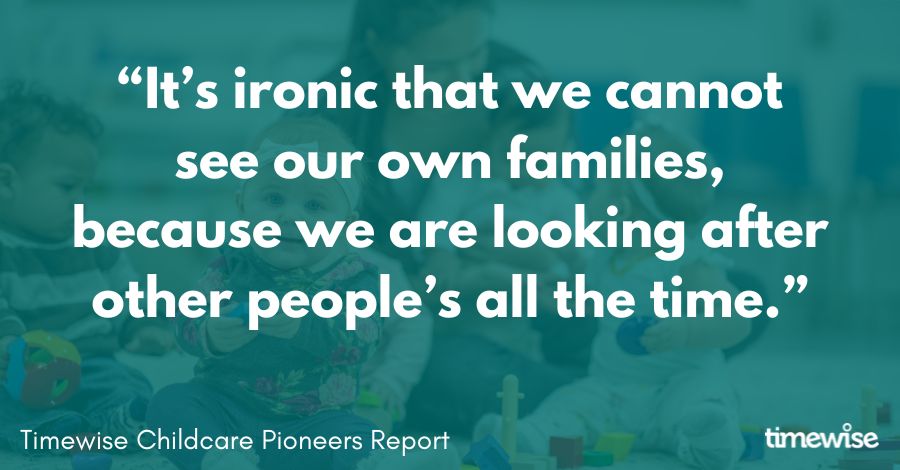
Part-time work across the sector has fallen in the majority of settings since 2018-19 with flexible working options generally achieved through the use of casual, agency or bank staff.
Managers recognised the potential benefits of offering flexible working but were concerned about continuity of care, maintaining staff-child ratios, meeting training standards, ensuring fairness and managing team dynamics. As one person described life in a nursery, “It’s a constant jigsaw.”
At the roundtable we heard a clear call to value those working in Early Years more highly, recognising that, “It’s not just about numbers, it’s about ensuring those who care and educate are energised, valued and motivated to do so.” There was an acknowledgement that emotional resilience is key in a workplace that demands a high level of emotional investment in children’s development and needs. And a sense that there is a need to better balance the workloads and schedules of those in such an intense working environment, to better support physical, mental and emotional wellbeing.
Increasing access and opportunity for the sector is a challenge, but through the research and numerous examples of good practice, it was proven to be possible within the operating constraints of the sector – all with the voice of the child front and centre. Innovative work practices included split-shift patterns (read Ruth’s story on page 11 of the report) and recruiting lunchtime assistants (page 18 of the report), housekeepers or tea-time assistants who enable flexibility across the wider teams. As Neil Leitch, Chief Executive of the Early Years Alliance put it, “You have to be creative. Continuity is critical but that does not mean you need always to see the same person.”
And it can also be used to enhance an organisation’s management capabilities. As June O’Sullivan OBE, the Chief Executive of LEYF said, “We need to think creatively about flexibility, in its wider context. For example, think flexibly about how you think about succession planning. It can help planning the next steps for staff or an experienced manager phase their retirement slowly, while helping a new manager to build their skills and knowledge.”
At a national level, Timewise is calling for a workforce plan that includes flexible working as a key strategic pillar. We estimate that a recruitment drive based around part-time and flexible working could attract staff to fill the equivalent of 17,850 full-time vacancies. That’s half the 35,000 shortfall the UK currently faces, to meet the expansion of 30hrs/week funded support.
Locally, we need authorities to bring networks of childcare providers together to share learnings, consider challenges and how to overcome them by exploring innovative practices such as sharing of bank staff. There was real momentum at our event around this idea – clearly they have a real ‘binding’ role to play. And for childcare providers themselves, we need to see a shift away from an individualised request-response model of flexibility towards a more pro-active whole-setting approach that encourages creativity and innovation and enables staff input into working patterns. To support this, Timewise have created a series of toolkits and resources for managers, which can be found here.
There is no magic wand with which to fix the staff and people problems that the early years sector is facing. But creating good standards of flexible working, in an industry where 98% of employees are women, many of whom have their own caring responsibilities, is not just good business sense. It’s a way to improve wellbeing and the lives of those playing the vital role of nurturing our future generations.
Our 9th annual Flexible Jobs Index© reports negligible change on the previous year’s level of job adverts offering flexible working. Only 31% do so, signifying an end to the progress that was made during and since the pandemic, when hybrid working became the norm for many UK jobs.
The stagnation is surprising in the light of the Employment Relations (Flexible Working) Act 2023, with its accompanying regulation giving people the right to request flexible working from day one in a new job. It suggests that many employers remain resistant to flexibility for new recruits, and are not preparing for the change that is coming when the new law is implemented next year.
To be fair to employers, complex workplace transformation takes time. And the pressure to adapt to flex coincides with huge challenges in terms of pay rises to cover the increased cost of living, whilst grappling with an economic downturn. However, it has never been more important to look beyond the barriers and consider the evidence that flexible working is a powerful talent attraction tool. Candidates increasingly want and expect to be able to work flexibly, and with new legislation on the way that is not about to change.
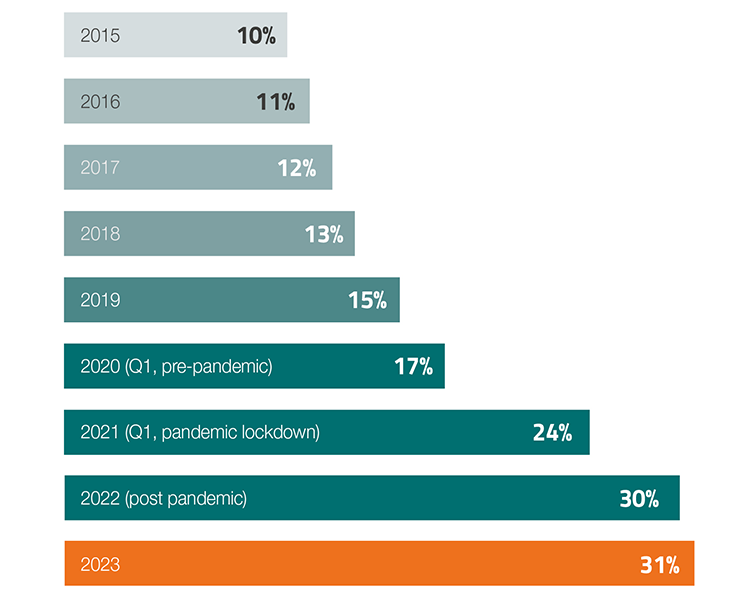
The proportion of job adverts which offer flexible working appears to be stalling. The 2023 rate of 31% represents barely any increase on 30% in 2022, and follows three years of a marked upward trend during and since the pandemic, as many organisations embraced hybrid-working.
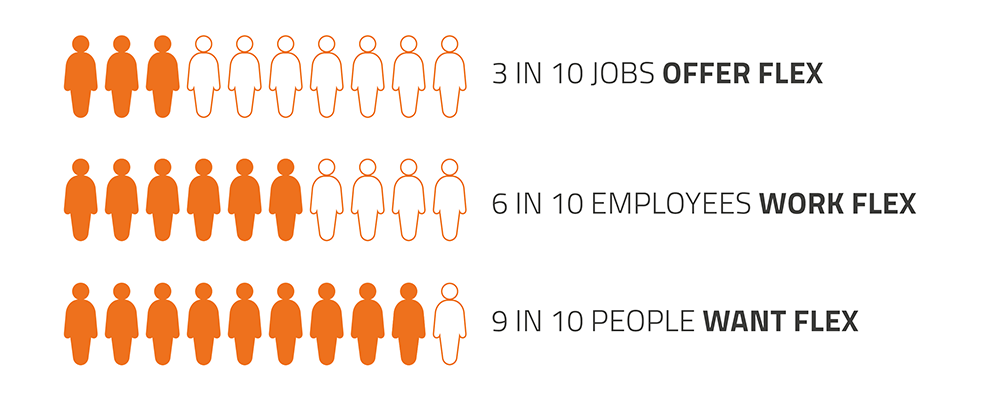
The supply of flexible vacancies lags far behind demand. 6 in 10 employees can access the benefits of flexibility in their current job, and many more people want to work flexibly. Yet only 3 in 10 jobs are advertised with flexible working – or, to look at it another way, people who need flexibility are unable to apply for 7 in 10 jobs.
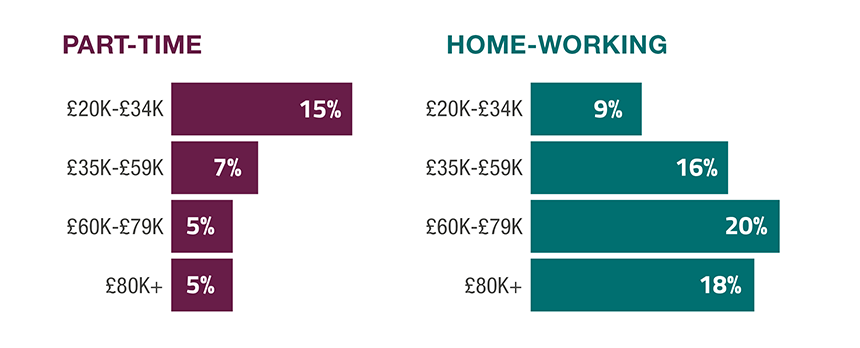
The higher the salary, the lower the availability of part-time jobs. Conversely, home-working (including hybrid working) is least available in lower paid jobs and peaks for jobs paid £60k-£79k.
These imbalances create unfairness in the workplace. The lack of part-time jobs at higher salaries traps many people in their low-paid part-time roles. It also creates barriers for those who take a temporary break from work and need a part-time role to re-enter the workforce. Meanwhile, hybrid arrangements, which make up the majority of home-working jobs, are primarily associated with higher-paid office roles and are inaccessible to many.
Greater parity can be achieved, if employers look more closely at what flexibility is possible in a role and design it into jobs.
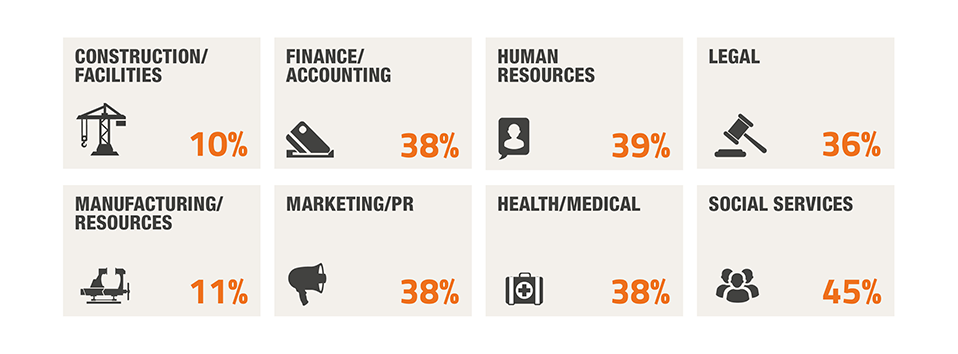
Access to flexible working at the point of hire varies widely depending on the type of role. Those that are largely based around shifts offer flex the most – for example social services (45% of job adverts) and medical/health (38%). Above average access to flex is also offered in a number of office-based role categories, because of increased home-working – for example, HR (39%), marketing (38%), and finance (38%).
But some role categories have stubbornly low rates of flex, such as manufacturing (11%), and construction (10%). This may be gender based – they are male dominated roles where historically low requests for flexibility may have shaped cultural resistance to it.
CIPD research published in May 2023 found that 49% of employers were not even aware of the 2023 legislation on flexible working, and the regulation around the day-one right to request it. So first, employers need to read up on the new legislation and think through how they will incorporate it into their processes.
The best way to gain knowledge and confidence on how to make flexibility work in your organisation is to find successful examples in your sector. Guidance on flexible job design will be helpful, as will advice on how to support line managers to implement flex.
Look particularly at how to make a success of hybrid working, which is currently the subject of much doubt amongst employers. Before you row back on hybrid, or decide not to trial it, invest time in understanding models that are successful.
And finally, it’s a mistake to assume that candidates will know they can ask for flexible working at interview. People who need flex want to know it’s on offer before they waste time on an application. This is especially true if they have been out of the labour market for a while, as they may lack the confidence to ask. So be sure to state clearly in your job adverts which types of flexibility are possible for the role.
Watch the Timewise Flexible Jobs Index© 2023 webinar below:

The suggestion that under a hybrid model, it will be women who predominantly opt to work from home, to the detriment of their careers, is understandable from a statistical point of view. Data from 2018 suggested that two thirds of mothers are the primary carer for their children. And during the pandemic, women carried out two thirds more of the childcare than men.
But it’s not that simple; and employers who assume it is are doing themselves and their other employees a disservice. The fact is, there are groups other than parents for whom working from home may also be a preference. And for some, lockdown-enforced remote working actually levelled the playing field in terms of access, availability and visibility.
For these groups, being supported to work from home without being affected by proximity bias is essential; badly thought-out hybrid arrangements could send their inclusion backwards. Here’s a look at some of these groups, and why it is in employers’ interests to make sure they’re properly included.
It’s been noted that autism is associated with characteristics such as loyalty, honesty and productivity, as well as logical thinking patterns and creative thinking skills, all of which are hugely valuable to employers. But for people with this condition, and others such as dyslexia, dyspraxia and ADHD, the office environment is not necessarily conducive to working.
For example, office lighting and acoustics can be tricky to navigate for people who struggle with sensory overload. And the social aspects of the workplace, and the battle to commute, can be exhausting for those who don’t find interaction easy.
So working from home, at least some of the time, could help these employees stay focused, and produce their best work. This is particularly the case if they are supported to work remotely in a way that suits their preferred communication method – for example, audio-only may work best for some team members.
From access issues for employees who use wheelchairs, to cancer patients’ need to attend appointments during the working day, working from home can minimise some of the complications that employees with physical health issues have to juggle. It also frees up time and energy (which they may need to use sparingly) for them to focus on doing a good job.
And with recent reports suggesting that fewer than one in three patients who were hospitalised during the pandemic feel fully recovered a year later, there is every indication that long Covid may become a real issue for employees. The ability to work from home will be key to helping them stay in the workforce.
It’s also worth remembering that some illnesses aren’t physical, or visible; the needs of employees with mental health challenges must also be taken into account. For employees with depression or anxiety, there’s no one-size-fits-all; but being able to work in a calm quiet space at home may be gamechanging for some, reducing stress levels and supporting the production of high-quality work.
And given the impact the pandemic is having on mental health – with ONS data from May 2021 revealing that depression rates had doubled since it began – a growing number of employees are likely to be affected in this way, and require support from their employers to thrive.
According to Carers UK, the Covid-19 pandemic has seen the number of employees with caring responsibilities rise dramatically, with the proportion of carers in any workforce now one in four.
For these employees, working from home can mean being able to visit or support their relative in their lunch hour, or at times when they would otherwise have been commuting. This has a positive effect on their own wellbeing and stress levels, which in turn, affects their ability to deliver for their employers.
Clearly, then, being able to work from home at least some of the time is a bonus for many members of these groups. And the impact that this has on their ability to deliver is good for their bosses, too. But there’s much more to it than that.
Diversity and inclusion isn’t just a box-ticking exercise; there are good reasons why organisations should aim to include a variety of experiences, viewpoints and skills. It opens them up to a broader range of perspectives and opinions, limiting the risk of groupthink and bringing more unique ideas and solutions to any given problem. It contributes to creativity and competitiveness; offers access to a wider talent pool; and makes it easier to get the right skillset for the job.
So what does all this mean for you? It means that if you want a diverse, inclusive workforce, whose employees offer an equally diverse range of skills and experiences, you need to create a culture in which they can thrive.
That means understanding your employees’ individual circumstances – remembering that not all challenges are visible. It means taking the time to understand what working arrangements will help your people to do their best work, and designing solutions that ensure that everyone is included. Training and empowering managers to have 1:1 conversations with their team members about workplace flex is a key part of this.
And in today’s Covid-affected landscape, it means deliberately working to mitigate against proximity bias, putting processes in place to make sure that people who are in the office more frequently don’t receive preferential treatment. If you’re not sure how to design inclusive hybrid working arrangements, we can help; do get in touch to find out more.
Published January 2022

By Amy Butterworth, Consultancy Director, Timewise
After nearly two years spent working in pandemic conditions, it’s time for leaders to review the successes and challenges they’ve experienced with flex and make concrete improvements for the future. Taking a few simple steps now will help turn concerns about the great resignation, the two-tier workplace and fragmented teams into opportunities to create a motivated, cohesive workforce.
During the pandemic we’ve bounced backwards and forwards between working from home and returning to the office. It’s felt chaotic and stressful, but the upside of this uncertainty is that we’ve experienced a variety of new working patterns. Now is an ideal time to be candid about what is – and isn’t – working for your team.
The resolution: Implement a specific plan to improve flex working
Set an honest, collaborative tone by consulting with your teams on their experiences and openly sharing the constraints you’re facing. This will allow you to decide on and implement clear, measurable actions to meet these challenges. Could a change in working hours or regular, virtual 121s help flex work more smoothly? Find the processes and patterns that will make your resolution stick and commit to reviewing them regularly.
2. The challenge: Address the imbalance of a two-tier workforce
Thanks to the swift introduction of working from home, many companies are being confronted with an unintended, unequal two-tier workforce and the dissatisfaction that can bring. Frontline workers who are required to be present in the workplace can easily feel resentful towards the hybrid workers who remain at home without having to spend time or money commuting.
The resolution: Expand your flex working options
Hybrid working should not be the only flexible working option available to employees. It places those on the frontline in industries like catering, transport and tourism at a significant disadvantage. Forward-thinking companies now offer flexibility around the timing and amount of work undertaken, as well as the location. One of our clients realised their hybrid working plans wouldn’t suit their entire workforce so they now plan to trial part-time working, flexible shift patterns and the option to work anti-social hours as well.
3. The challenge: Engage detached, disheartened teams
Despite everyone’s best efforts, the last two years have seen the cancellation of team-building events and parties alongside the abandonment of communal office spaces, leaving workers feeling increasingly detached from their managers and colleagues. Maintaining shared goals and a sense of camaraderie is key to achieving targets and engaging employees – so what can be done?
The resolution: Set aside time to connect with your employees
The intensification of work has made it tempting for leaders and managers to spend the time that would have normally been spent on physically engaging with their teams on other tasks – but that’s a mistake. Even when you can’t bring people together in person, you need to ring-fence that time and find alternative ways to engage with them instead.
This could include simple day-to-day actions, such as building informal catch-up time into your virtual meetings and allocating team ownership for activities and goals. It could also be through fun, creative ideas such as learning circles, gif battles or online lunch dates. To engage a flexible workforce and improve team connection, you’ll need a range of in-person and virtual options.
4. The challenge: Ensure hybrid workers aren’t overlooked
Out of sight, really could mean out of mind when it comes to career progression for hybrid workers, particularly women who often combine flexible working hours with family and caring duties. LinkedIn has found that a third of UK business leaders and nearly half of UK workers are concerned about the favouritism of proximity bias – the tendency to promote workers visible in the office at the expense of those working from home.
The resolution: Give hybrid workers a clear career plan
To make sure hybrid workers have a fair chance of promotion, spend longer than usual defining, “what good looks like” with them and make sure you set measurable outcomes-based objectives. Challenge yourself to reward and recognise people for the outcomes they achieve rather than the number of hours they are present in the workplace.
5. The challenge: Turn the great resignation into a great opportunity
Triggered by a dramatic increase in remote working options, the great resignation of workers who quit their jobs in 2021 to find more flexible options looks set to continue. Rather than looking on this upheaval as a negative, this change to the working landscape can offer an opportunity for employers to attract loyal and highly skilled talent.
The resolution: Shout about your flex options to attract new talent
Design any jobs you’re advertising with flexible working built in, and make it obvious which options are on offer – whether that’s homeworking, part-time, variable hours or an alternative. Promising a vague flexible working culture is simply not enough to gain the trust of potential employees.
Action any or all of these resolutions and you’ll be well-placed to build a robust, motivated and united team, ready to take on whatever this year may bring. At Timewise we can equip you to create a successful flexible working strategy for the future of your business so you can thrive in 2022 and beyond; contact us to find out more.
Published January 2022
By Amy Butterworth, Consultancy Director, Timewise

The government’s decision in early December to implement Plan B sees employees once again being asked to work from home where possible. Even before the arrival of the Omicron variant, Deputy Chief Medical Officer, Jonathan Van Tam had stated that we might not experience workplace normality until spring 2022. With the new variant in play, this is likely to be delayed further.
So, hybrid working is here to stay, but how is it working in practice? Here we explore some of the positive initiatives which are happening on the ground, as well as the challenges that lie ahead.
From traditional 9-5 offices to innovative start-ups, everyone has been on a steep learning curve about hybrid working. As a result, we’re talking more openly about working patterns, wellbeing in the workplace and flexible opportunities, all of which can be supported by hybrid working.
And while the government’s proposed Flex from Day one legislation leaves the onus on the employee rather than the employer to suggest flexible working conditions, it’s certainly a step in the right direction.
The humble lanyard has been a surprise hit in helping establish safe, flexible working. Some businesses, including our client Michelmores LLP have introduced a traffic light lanyard system to reflect the amount of contact employees feel comfortable in allowing. Wearing a red lanyard means, ‘Hi! I’m keeping my distance’, amber says, ‘Okay with talking but not touching’, while green indicates, ‘Okay with hugs and high fives’.
Similarly, the Department of Health and Social Care has provided downloadable badges saying, ‘Please give me space. Be kind. Thank you for understanding’, for those concerned about social distancing.
Feeling like part of a team is hugely important for achieving shared goals and boosting morale, but it’s hard to build those essential bonds on a screen. At the same time, some tasks require a level of focus that’s hard to achieve in the office. Hybrid working has freed up office-based employees to match the work to the location, working from home on deep-dive projects and coming in for connection and collaboration.
The gradual return to the office has given everyone more time to prepare for a hybrid working reality. Companies have been able to set up desk-booking systems to manage office availability, discover whether Zoom, Skype or Slack works best for their employees and adjust to the complications of managing teams in differing locations.
Of course, as well as the positives that are coming out of hybrid working, there’s no question that it is raising some unexpected challenges. When the pandemic started there was a great deal of goodwill between employers and employees. Now, as temporary measures become more permanent, there are many questions to face and answers to discover.
While knowledge workers such as accountants and lawyers can work productively from home, 46% of UK employees still don’t have access to flexible working according to CIPD research. Workers in areas like retail and construction often need to be physically present in their place of work; most office workers at BT, for example, will be able to work from home one or two days a week, but that flexibility won’t apply to the company’s engineers.
It’s a common dilemma for managers and, as we’ve noted previously, the risk is that a two-tier system could develop where location workers lose out in terms of pay, benefits and lifestyle.
Bank of England policymaker Catherine Mann has warned of a she-cession, with female employees becoming less visible and influential in the workplace because they opt to work from home. But loss of influence while working from home is also a risk for people with health issues, those in caring roles, introverts who thrive in quieter environments and indeed anyone who desires a better balance for their work and home lives.
Getting hybrid right means creating an inclusive culture and practices which takes all these groups into account.
Remote and hybrid patterns mean we need to consider how we are judging employee contributions and performance. Not being able to share an office means that you may not be aware of all their interactions with colleagues and clients. And how can other staff members give feedback for a 360° evaluation if they only see their co-worker during the occasional Zoom meeting?
Similarly, it’s important to consider whether employee objectives are focused on outputs or are subject to hybrid bias. And to review your own approach to evaluating performance; is it overly based on visibility rather than delivery?
Remote working has made it possible for people to compete for high pay, high prestige jobs in cities without having to live there or even commute, so how can suburban and rural companies compete? What unique benefit or EVP (employee value proposition) could be offered? What should happen to London weighting allowances? How should HR departments calculate market rate salaries?
These are tricky issues – but they cannot be ignored, because hybrid working is here to stay. Employers who want to attract and retain the brightest talent need to take action to ensure a motivated, successful team for the long term.
Published December 2021
The event was hosted by our Development Director, Emma Stewart, and featured a panel of business leaders who provided their own insights and analysis about what they’re seeing on the ground, as well as their suggestions for what needs to be done to shift the dial. We’ve included a recording of the event below.
Among the key themes which emerged were:
Our thanks got to our panel for sharing their insights and experience: Neil Carberry, CEO, The Recruitment and Employment Confederation; Jonny Briggs, Head of Talent Acquisition and D&I, Aviva; Farrah Ekeroth, Head of Employer Brand, EY and Jane Galloway, Head of Flexible Working, NHS England.
By Amy Butterworth, Consultancy Director, Timewise

Bank of England economist Catherine Mann’s views on the impact of homeworking on women’s careers have certainly caused a stir. Speaking at an event hosted by Financial News magazine, Ms Mann noted that many women (particularly those with family responsibilities) were continuing to work from home, whereas men, for whom it was easier, were increasingly returning to the office.
As Ms Mann noted, this represents a real risk for female career progression: “There is the potential for two tracks. There’s the people who are on the virtual track and people who are on a physical track. And I do worry that we will see those two tracks develop, and we will pretty much know who’s going to be on which track, unfortunately.”
Yes, it’s a risk, but it’s not inevitable – and it’s not just women who are affected
Here at Timewise, we’d agree that this is a risk; indeed, it’s something we’ve been highlighting for some time. As we noted back in January 2021, unevenly implemented hybrid working and behavioural bias can lead to an influence gap between an office-based ‘in-crowd’ and their more remote-based peers.
And while women with family responsibilities are disproportionately likely to be affected, they’re not the only ones. Introverts, carers, or people with mental and physical health needs may also prefer to work from home, for very valid reasons. Not to mention those who don’t have any specific circumstances, but who have discovered that a balance of in-office and working from home has dramatically improved their wellbeing, and want to stick with it.
However, the good news is, this really isn’t inevitable. It is within employers’ power to mitigate the risk, by having a proactive, flexible working strategy in place, and developing an inclusive culture in which remote and in-office workers are equally respected and represented.
So employers who care about inclusion, diversity and career progression for all (which is as good for business as it is for individuals), or who want to have a wide talent pool to choose from when recruiting (which is critical in the current skills shortage era) need to step up and make it happen. Here’s how.
Instead of making office work the default, and working from home an option that people can take-or-leave, design a deliberate, considered hybrid approach for everyone. This could include setting an expectation that all members of the team whose jobs allow have a balance of in-office and WFH time – including senior leaders. Or requiring managers to have proactive conversations with their teams about ways of working and what patterns will work best.
And remember to make it worth people’s while to come in; office time should be spent on activities where in-person collaboration is helpful, rather than sitting at a desk with headphones on to drown out the noise. Look at what tasks are best carried out at each location, and encourage people to map out their week accordingly.
To do this well, we’d recommend skilling up your HR and management teams in flexible job design. We can help.
The chances are, your performance management processes were created for the pre-Covid era – which means they may not be fit for hybrid purpose. So, for example, make sure your performance management systems focus on outputs and outcomes rather than inputs. And create processes to make sure that projects are allocated fairly, rather than just to the person who happens to be sitting next to you.
We all got used to Zoom and Teams meetings during lockdown, but when some of the team are in and others are out, you need to use different tactics to create an even playing field. For example, we suggest allocating an in-the-room buddy to those dialling in to a hybrid meeting, to advocate for them in the room and make sure their views are heard.
It’s also worth thinking about other key elements of the employee lifecycle which may need adapting to a hybrid working pattern, such as recruitment, onboarding and training.
And it’s not just about meetings; it’s also worth remembering that supporting a hybrid team requires different communication plans and management skills, so managers need to be trained to do it well.
Understanding whether this risk is materialising into a reality in your company is something you’ll need to keep an eye on. So we’d recommend putting in place a process for monitoring the progression and retention of your flexible workers.
To do this – and to do it well – will doubtless require an investment of your time and energy. But it’s worth it on so many levels – indeed, we’d argue that you can’t afford not to.
If you are serious about diversity and inclusion, and linked issues such as the gender pay gap, you need to create equality of opportunity for colleagues for whom being permanently in the office isn’t ideal. If you believe that having happy, well-balanced employees is as good for the business as it is for them, and want to attract, keep, and nurture brilliant people, you need to offer them the flexibility they say they want.
Ideally this would be broken down into the different forms of flex (hybrid, WFH only, part-time) so you can track the impact on different cohorts. This will help you take action against the type of two-track career progression that Mann cautioned about, and create flexible career paths to enable your talent to thrive.
And if you are keen to be seen as a forward-looking employer, you need to develop a new way of working, rather than reverting to pre-Covid norms. Your brand reputation – and your staff – are counting on you to do just that.
Published November 2021
Since March 2020, a workplace revolution has taken place. Pandemic-enforced lockdowns have triggered a huge uplift in remote working, which appears to be here for the long term; at the time of writing, large numbers of employees who previously worked in offices remain home-based, and many companies are offering hybrid working arrangements for their teams.
But while much has been written about the move towards location-based flexible working – that is, people working from home or in other off-site locations – there has been little, if any, attention given to time-based flexible working, particularly part-time. Put simply, the voices of people who cannot work full-time, and their experiences during and after the pandemic, are not being heard.
This report sets out to remedy this omission; to listen to the experiences of part-time workers and job seekers, and understand how the pandemic has impacted them. It builds on the quantitive data from our first Fair Flexible Futures report, providing real-life insights that will help employers, policymakers and labour market intermediaries drive more inclusive policy and practice.

The crisis in sectors like retail and hospitality has led to huge numbers of part-time jobs simply disappearing. There’s also been an increase in the number of people switching from part-time to full-time work, largely due to the need to compensate for cuts in family income caused by furlough and redundancy. As a result, the rate of women in part-time jobs has fallen to the lowest level since records began.
Whilst the pandemic has thrust flexible working into the spotlight, and driven a huge increase in the uptake of remote working, the same can’t be said for the nation’s favourite form of flex: part time.
So part-time is taking a post-Covid hit, and this matters. Why? Because for many people, and particularly those who have caring responsibilities, or health issues, the lack of availability of part-time jobs can be the difference between working and not.
And it also matters from a business perspective. Employee demand for part-time is strong (a third of men and a quarter of women want to reduce their hours post-pandemic) and offering it is a sure-fire way to tackle strategic issues such as diversity and inclusion, wellbeing and the gender pay gap, as well as talent attraction in a time of candidate shortage.
We invited three of our Power List alumni to join Timewise leaders on a panel at our recent roundtable: TBWA’s Sarah Tate; Lee Clements, from LSEG, and EY’s Victoria Price. All at senior leadership level, they discussed how they are making sure that part-time doesn’t get forgotten in the rush towards remote – and how their organisations are benefitting.
Accept and overcome the barriers to part-time
Although the business case for part-time is increasingly understood, our panel felt that various barriers, real or otherwise, were still getting in the way of change. Here are the barriers they identified, and how to overcome them:
Prioritise getting the best out of people
From the increased focus on ESG strategies to the adoption of the United Nations Social Development Goal 8, looking after your people is rightfully becoming a higher priority for businesses. And offering flexible and part-time roles is a key way to do so.
Our panel agreed that there are some specific people management approaches that will help you encourage and grow your part-time employee base:
Adapt your own processes and attitudes
Finally, you’ll need to make sure that the processes you have in place are as suitable for part-time candidates and employees as they are for full-time ones. Our panel highlighted the following areas to consider:
It’s in everyone’s interests to increase access to part-time – follow our panel’s advice and build a culture and framework that will deliver for you and your employees. And if you need any help, please get in touch.
By Amy Butterworth, Principal Consultant, Timewise

There’s a growing sense out there that it’s time to start bringing people back into the office. With restrictions having eased on 19 July, and the worst of the pandemic (hopefully) behind us, leadership teams all over the UK appear to be planning a full-scale return, albeit, in many cases, on a hybrid basis.
However, the move towards more office-based work isn’t universally popular; one IPA/Opinium survey found that only 31% of adults favoured a full-time return to the office, with fully flexible approaches and a hybrid 3:2 model both preferred. Some are being hugely vocal on the subject; employees at Apple wrote a letter to their CEO in June responding to (and rejecting) the proposal that they would be required to return to the office for three days each week.
As a result, leaders who believe the return to the office has clear benefits are left treading a delicate balance, between supporting their employees’ work preferences and doing what they think is right for the organisation. It’s not a straightforward one to fix, but it does need fixing; forcing people to come back in against their will won’t work for them or the organisation. Instead, here are some suggestions for how you should approach it.
The first thing to do, if you haven’t already, is to find out what your employees are thinking and feeling. What’s the appetite for coming back into the office, and what are the objections? What could you do to help them feel more comfortable? For example, would a simple adjustment to the timings of their working day that cut out rush hour travel make a difference to their preferences?
Once you’ve understood how people are feeling in general, you need to dig deeper into any concerns. And there are likely to be a wide range of reasons why people are unwilling to return.
For some, working from home will have changed their lives for the better, such as replacing commuting with exercise time or being able to share childcare. Others may genuinely feel that they’re more productive outside of the office; some may have even relocated on the assumption that they will be able to work some of their week from home. For others, particularly those with health issues or dependents, there may be real fears about exposure to Covid-19 or their ability to juggle their responsibilities.
Recognising the benefits that remote working has brought your employees, and registering their concerns about returning, will help you design a solution that allows them to hold onto the good stuff, and feel supported to manage their specific needs.
Armed with these insights, you need to ask yourself this question: what are you asking your employees to come back in for?
Given the concerns that people may have, you’ll need to make sure it’s worth it; simply expecting them to come in just to sit at their desks and work like they used to won’t be enough. And nor is it sufficient to trot out the line that people should ‘come in for collaboration’; that’s just too vague.
So instead, take this as an opportunity to re-evaluate not just the office, but the working day. Start from scratch, challenging assumptions and long-held ways of doing things. If you could design the best way to deliver your company’s objectives, what would it look like? If you were to rethink the working day, with wellbeing and productivity as your focus instead of hours clocked, what changes would you make?
And involve your team in this process, to make sure that the changes you agree will stick. For example, as part of our hybrid workshop for line managers, we advise carrying out activity analysis with their teams. This involves looking at the different types of activity needed to deliver their goals, and the best time and place to do them.
This process of exploration will give you a platform to work out what the purpose of your office should be, and to explain to employees why, and when, you would like them to come in.
As part of the evaluation process, you’ll need to make sure you’re not being swayed by your own preferences and biases. Are you keen to bring people back in because that’s how you prefer to manage? Does it just feel easier to go back to how it’s always been done? That’s not a good enough reason to stick to the status quo.
Similarly, if your line managers are nervous about being in charge of a team they can’t see, that isn’t a reason to make everyone come in. Upskilling your managers to support and develop remote colleagues is a far better solution.
Finally, it’s worth remembering that there is no one-size-fits-all for flexible and hybrid working. So whatever your new office set-up and working day looks like, there will still be some people for whom it isn’t appropriate, or who may need additional support.
For example, even if you decide that certain team meetings need to be attended in person, you should still make provision for anyone who can’t attend, such as allocating a buddy in the room who can advocate for their airtime. By making inclusivity a priority, and thinking beyond the technology, it should always be possible to find a solution.
The bottom line is, there is no going back, at least not for people-focused, forward-looking organisations. The shifts caused by the pandemic are too wide, and too deep, to be overturned; employee demand for flexible options is higher than ever, and you risk damaging your retention strategy and your employer brand if you don’t respond. And of course, you would also miss the opportunity to build back better. But these are big strategic issues to explore, and you may need some help; if you’d like to know more about how we could support your process, please do get in touch.
Published July 2021